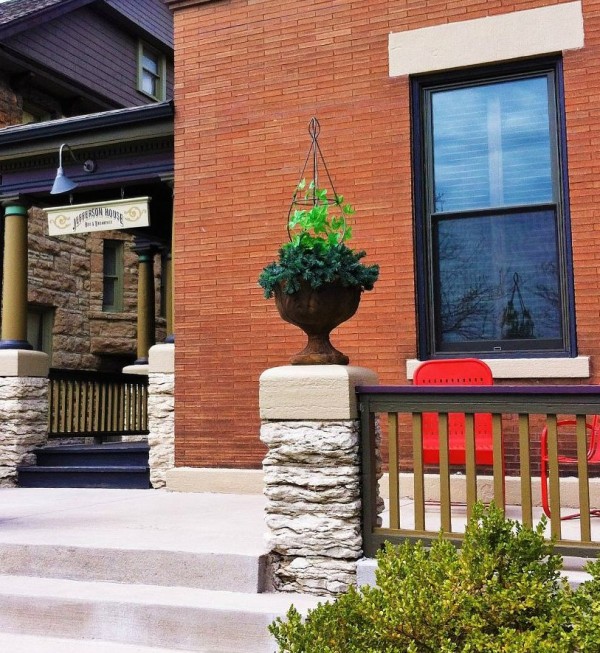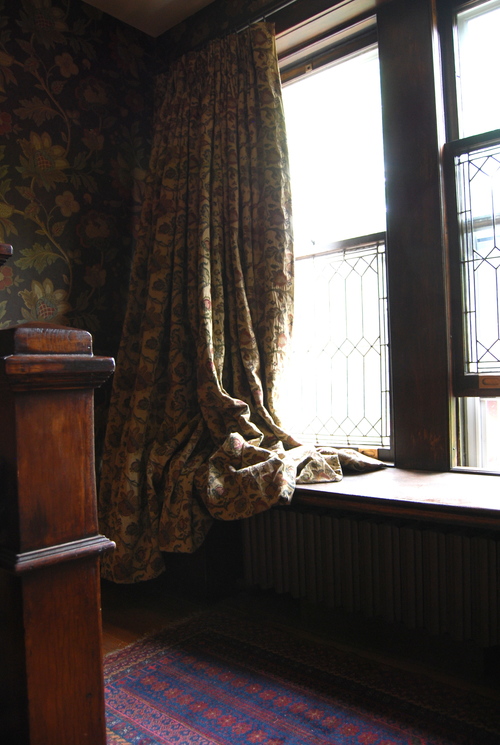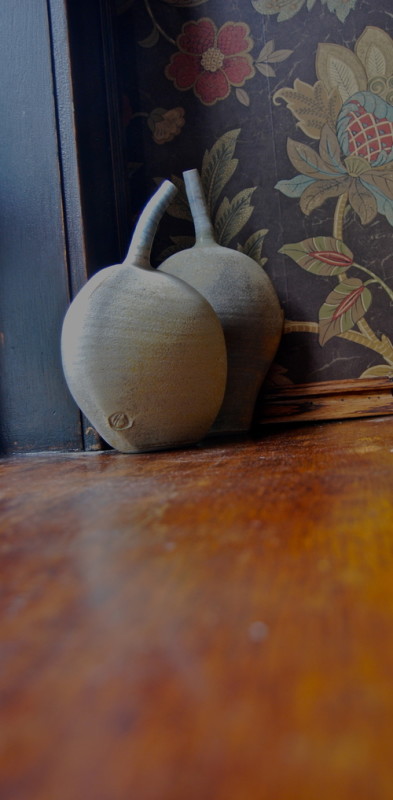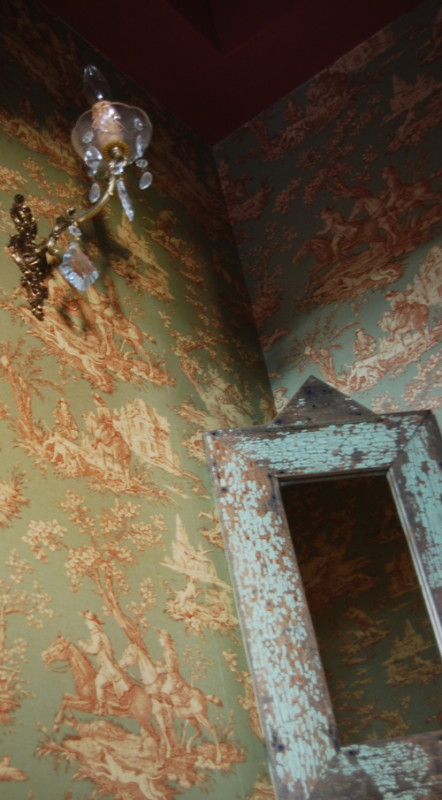Jefferson House Bed & Breakfast
Bed & Breakfast, pottery studio, Murdock Suite, Mulkey Suite, Summit Room

When owners Peter and Theresa Robinson renovated the Jefferson House Bed & Breakfast, a 13-room inn built more than a century ago, they chose tasteful European touches that engage the original charm of the house. The façade, like so many historic homes in Kansas City, Mo.’s, Westside neighborhood, remains intact with locally made red-clay bricks and appears the same as it did when built in the 1890s. Jefferson Street was once the wealthiest area in the Westside, home to uniquely designed brick and stone mansions atop a bluff that boasts the best cityscape in Kansas City. Other homes in the neighborhood were erected in the Kansas City Peak style, a tweak on Italianate style with peaked roofs and circular windows overlooking the streets below.

The Westside was established after the Civil War, spanning 13th to 31st Streets, its growth significantly attributed to Mr. William K. Mulkey. A North Carolina native and trader of Indians and horses, Mulkey settled in the Town of Kansas in 1828 with his wife, Catherine Dripps, whose father, Andrew Dripps, owned land here. The houses on Jefferson Street are all more than a century old, and Mulkey himself built the very first brick home in Kansas City at nearby 13th and Summit Streets, on the northern side of the bluff in 1857. Although Mulkey was the first to truly settle in the residential district, in 1831, William Gillis (one of the original investors who platted the Town of Kansas) arrived in Jackson County. With the fortunes made from trading with Native Americans (mostly Delawares), Gillis built a mansion and elegant plantation that comprised most of the area we now call Westside. After looters ransacked the Gillis Mansion, he moved his home to 4th and Locust Streets in the River Market.
Thus Mulkey acquired 125 acres of land, confident in the Town of Kansas’ growth. He platted and sold plots of his land for $1,000 each – not to contractors, but to individuals – and it did, indeed, see a surge of development. He also donated ground at 16th Street and Belleview Avenue, which became Kansas City’s first public park.
The district quickly evolved, becoming known as “Irish Hill” due to the large number of Irish-born workers who settled along the bottom of the bluff. As many of these laborers prospered from their work on the railroad, they relocated to the top of the cliff. By the early 1900s, the Westside was the only neighborhood where the very wealthy dwelt along rows like Jefferson Street, so very near homes of lower socioeconomic classes (or “worker’s cottages,” according to historian Andrew Jackson Downing)- a rare divergent community of the times.
Kansas City drew another businessman away from his hometown of Milwaukee, Wis., in 1878. Charles A. Murdock (former partner in the Milwaukee coffee and spice company Jewett and Sherman) assimilated himself into the Westside neighborhood, establishing his successful C.A. Murdock Manufacturing Co. An exporter of wares such as Hecla Coffee, spices, Manhattan Baking Powder and flavor extractions, Murdock’s company became a staple in Kansas City for many years. He also served in various high-regard positions with stakes in the Bank Directory, the Kansas City Club, the Kansas City Chamber of Commerce, Kansas City, Mo., River Navigation and the Priests of Pallas festival — an annual affair meant to rival Mardi Gras. With his fortune, he commissioned his new brick home at 1728 Jefferson St., present-day Jefferson House Bed & Breakfast.

In years following, the Westside deteriorated. A large Mexican-American population overtook the Irish denizens as the younger generation of the Westside moved to trendier neighborhoods like Hyde Park. The original residents grew old and passed, and their homes’ upkeep was long forgotten. Hard times during the Great Depression of the 1930s and World War II saw the Jefferson Street mansions sundered into apartments and boarding houses. With the arrival of the 1950s came an enormous highway project. Huge expanses of land were cleared, and the Westside divided into unwelcoming sections – utterly “ravaged by the highway program,” a Missouri government survey proclaimed.
At present, however, the Westside is experiencing immense growth as a once-more desirable area, along with the entirety of Kansas City. With attractions such as the Sprint Center, the Kauffman Center and First Fridays, the city’s visitorship and economy are flourishing.
Peter and Theresa Robinson seized opportunity and purchased the old Murdock house in Mulkey Square (roughly 13th Street to 16th Street) in 2010 and spent two-and-a-half years in renovations. A couple with grown children, the Robinsons have resided anywhere from San Francisco, Calif. to London, England. You’ll observe the English nod in the food at Jefferson House, lovingly prepared by Theresa, a potter and former sous chef. Perhaps for breakfast you’ll choose the Morning Toad-in-the-Hole or the Smoked Salmon and Asparagus Flan with feta cheese scones (whoops – just drooled a little on the keyboard). To enter the large kitchen where meals are prepared, one must pass through a “butler’s door” – the original hinge that allows the door to swing both open and shut. It was the clincher for Theresa in deciding on the house. The kitchen overlooks the garden and bears beautifully patterned silver-gilt tile.
The Robinsons occupy the house, and designate three bedrooms and bathrooms for guests. Out back, Theresa keeps a pottery studio. You’ll find many ceramic pieces throughout the house; nearly all of it is her work. Theresa moved from the United Kingdom to Kansas City’s Westside upon her acceptance into the renowned Red Star Studio’s residency program. The studio was then located just a block away from their current home, the program held in the old Red Star Yeast building erected in the 1920s. Peter joined her halfway through, and the couple fell in love with the Westside, moving here permanently not long after.

European art adorns many of the walls, all pieces the couple has collected throughout the years. A fresh coat of teal paint on the ceiling of the wraparound porch produces a modern pop, and the comfy red deck chairs boast the perfect seat for a stunning view. Refinement comes to mind when attempting to describe the home’s interior. The Murdock Suite, the Summit Room and the Mulkey Suite are the quarters guests may choose between. The original-owner namesake Murdock Suite has a private outdoor patio, while the Summit Room holds a grand claw-footed bathtub – original to the home. The Mulkey suite is named after the first Westside settler and features a leather Victorian-era writing desk.

The Jefferson House is within walking distance to several entertainment venues and districts – and delicious local eateries, including Westside’s Fervere bakery, where Peter spends his Fridays, and which he claims is the best bakery in at least the Midwest.
A far cry from his former position with the U.K. government, he works at Fervere to involve himself in the community and, as he says in a pleasant voice, “impress people with my British accent.” Peter often finds himself victim to the question of why he chose Kansas City over all the other amazing places he’s lived. His answer is always the same: “You don’t know what you’ve got here.” He’s right, Kansas Citians—we’ve an illustrious and industrious past with promise of a progressive and dynamic future.










